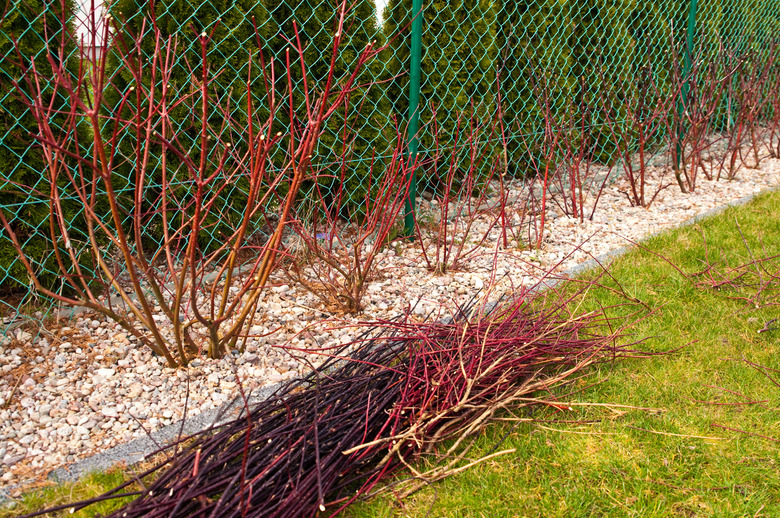Companion Plants For Red Twig Dogwood
We may receive a commission on purchases made from links.
Home landscapes can be as beautiful in the winter as in summer if you plan ahead. For example, brilliant red stems take center stage after the leaves on red twig dogwoods fall. Several dogwood species are marketed as red twig dogwoods, all growing 3 to 8 feet tall, depending on the cultivar. Like many other plants, they thrive in moist, sunny locations.
Basic Cultural Needs
Basic Cultural Needs
Red twig dogwoods, which include tartarian dogwood (Cornus alba, USDA zones 3-7), redosier dogwood (C. sericea, formerly known as C. stolonifera, USDA zones 2-7) and bloodtwig dogwood (C. sanguinea, USDA zones 4-7), grow best in full sun in moist, well-drained soil. Once well established, they're moderately drought tolerant and need supplemental watering only during hot or windy weather, but these adaptable shrubs also grow well in landscapes that are subject to periodic flooding.
Red twig dogwoods tolerate partial shade, although their red twig color is best when the shrub grows in full sun. For the most intense color, use the appropriate pruning tools to cut back one-third to one-half of the stems to ground level in late winter or early spring, since the youngest stems have the brightest color. Fertilize the shrubs with an all-purpose fertilizer after pruning.
Good Companion Trees
Good Companion Trees
Trees that enjoy the same sunny, damp but well-draining sites as red twig dogwoods include red maple (Acer rubrum, USDA zones 2-9), pin oak (Quercus palustris, USDA zones 4-8), red oak (Q. rubra, USDA zones 4-8), Austrian black pine (Pinus nigra, USDA zones 4-7), and dawn redwood (Metasequoia glyptostroboides, USDA zones 4-8). For sites that experience periodic flooding, consider white and weeping willows (Salix alba var. sericea, USDA zones 2-8, and S. babylonica, USDA zones 6-8), and bald cypress (Taxodium distichum, USDA zones 4-9).
Suitable Companion Shrubs
Suitable Companion Shrubs
Red twig dogwood's bright red winter color really sings when it's planted near yellow-tinged evergreens such as American arborvitae (Thuja occidentalis, USDA zones 2-7) and Chinese juniper (Juniperus chinensis, USDA zones 4-9), both of which grow well in damp soil that's well-drained. In summer, the variegated foliage of red twig dogwood cultivars, such as Elegantissima and Arctic Sun sparkles against dark-leaved shrubs such as hollies (Ilex spp.) and viburnums (Viburnum spp.).
If your red twig dogwoods are in a boggy spot that doesn't drain well, winterberry hollies (Ilex verticillata, USDA zones 3-9), summersweet (Clethra alnifolia, USDA zones 3-9), chokeberry (Aronia arbutifolia, USDA zones 4-9) and highbush blueberries (Vaccinium corymbosum, USDA zones 3-8) are all good companion shrubs.
Good Companion Perennials
Good Companion Perennials
Hardy hibiscus (Hibiscus moscheutos, USDA zones 5-9), a southeastern native plant, thrives in the same damp, sunny conditions as red twig dogwoods and puts on a show-stopping display of huge flowers in late summer and fall. Black-eyed Susans (Rudbeckia spp.), ornamental grasses such as fountain grass (Pennisetum spp.) and maiden grass (Miscanthus sinensis, USDA zones 5-9), asters (Aster spp.) and daylilies (Hemerocallis spp. and hybrids) all grow well in moist, well-drained soil in full sun.
Red Twig Dogwood Shady Companions
Red Twig Dogwood Shady Companions
For red twig dogwood plantings in partial shade, combine the shrubs with perennials such as primrose (Primula spp.), cardinal flower (Lobelia cardinalis, USDA zones 3-9), golden creeping jenny (Lysimachia nummularia 'Aurea,' USDA zones 3-9) or astilbe (Astilbe spp. and hybrids). Good shrub companions for partially shaded sites include golden privet (Ligustrum x vicaryi, USDA zones 5-9), azaleas (Rhododendron spp. and hybrids), and andromeda (Pieris japonica, USDA zones 4-8).
Shade-tolerant trees include serviceberry (Amelanchier canadensis, USDA zones 3-8), Japanese maples (Acer palmatum, USDA zones 5-8) and, of course, any of the tree-form dogwoods, such as the native American flowering dogwood (Cornus florida, USDA zones 5-9) or the kousa dogwood (C. kousa, USDA zones 5-8).
